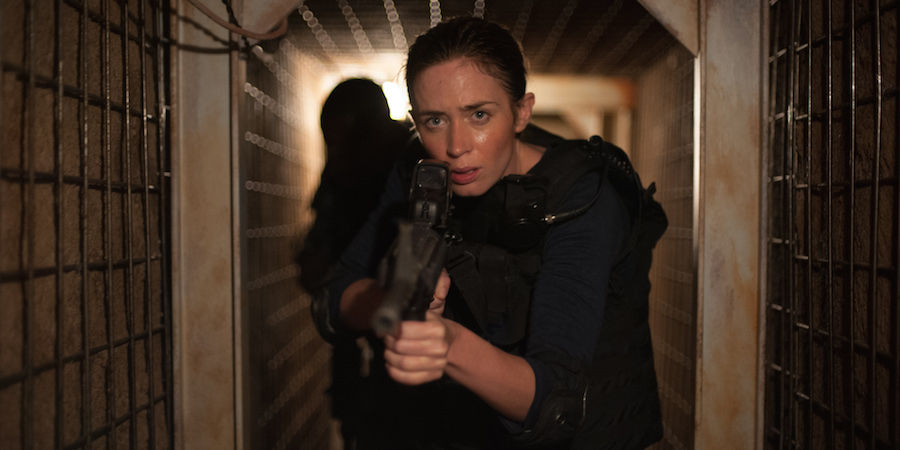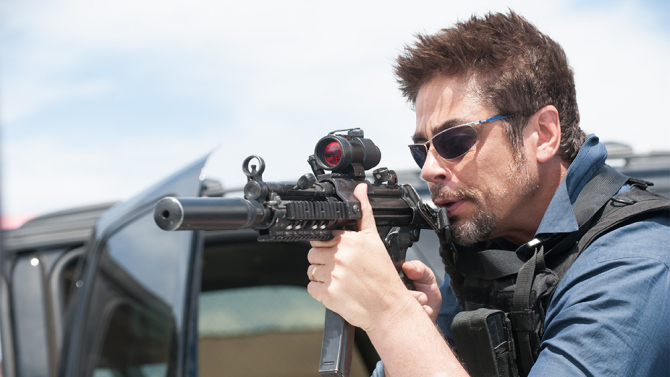Sicario – Film Review
Reviewed by Damien Straker on October 3rd, 2015
Roadshow presents a film by Denis Villeneuve
Produced by Basil Iwanyk, Thad Luckinbill, Trent Luckinbill, Edward McDonnell and Molly Smith
Written by Taylor Sheridan
Starring: Emily Blunt, Benicio del Toro, Josh Brolin and Victor Garber
Music by Jóhann Jóhannsson
Cinematography Roger Deakins
Edited by Joe Walker
Rating: MA15+
Running Time: 121 minutes
Release Date: September 24th, 2015
Emily Blunt is terrific in the new crime thriller Sicario, the name of which means “hitman” in Spanish. After starring mostly in romantic comedies, the English actress Blunt has transitioned into the action genre with films like Edge of Tomorrow (2014) and Looper (2012). But here, she delves so deeply into her character’s confusion and internal angst that the actress recognisable from these films disappears, replaced by a tortured and immersive performance of the highest order. She excels playing FBI agent Kate Macer, a woman with few personal connections, except for her friendship with fellow investigator Reggie (Daniel Kaluuya). Following a raid in Mexico, which unveils multiple corpses and an explosion that kills several cops, Kate and Reggie are enlisted by a shady set of government types who recruit her with a mission to hunt down a drug lord; they use her desire to bring the men responsible for the ambush on her colleagues as emotional leverage. The most prominent of these men is Matt Graver (Josh Brolin, doing some of his best recent work) and the other is the mysterious Alejandro (a tremendously oily, mysterious and unpredictable Benicio Del Toro). Alejandro is the most ambiguous figure, as no one will outrightly say if he belongs to an organisation like the CIA or some other allegiance. Only towards the end of this complex investigation do his motives become more transparent.
The tight relationship between the director Denis Villeneuve (Prisoners), cinematographer Roger Deakins (True Grit) and Blunt is unearthed in a number of sequences that show precise visual and stylistic choices. There has been a lot of discussion recently about films losing their visual flair as they look to imitate the dialogue-driven form of television, given to the rise of HBO and similar channels. But thankfully, Sicario lays waste to the misguided notion that films are no longer cinematic or visually inclined. The film is superbly photographed and framed by Deakins and Villeneuve, who use the shape, locations and spatiality, rather than words, to convey the thematic ideas in the narrative. One of the most impressive sequences in the film is a set piece where Kate is seated in the back of a car and being driven through the streets of Mexico. In this incident, the big black cars accompanying her vehicle fall into a procession and become indistinguishable from one another. The same is also true of the various police vehicles on the road. Meanwhile, Deakins also employs enormous, sweeping overhead shots to emphasise the anonymity of the various housing blocks and streets throughout Mexico. Through these formal choices and the images, the film creates visual conflict as an extension of Kate’s inner most feelings of self-doubt and vulnerability. Like the audience, her destination at the hands of these men is confused; similarly, her surroundings in this hugely dangerous and creepy world, where bodies are strung up in public, blur together into a haze where cops and criminals become inseparable. In a standoff in the traffic, the police open fire on gun totting thugs before they even raise their weapons. A police officer also opens fire on Kate, forcing her to dispose of him. The visual anonymity, created by the formal choices, are paired with the action sequence to reinforce how political and moral boundaries dissolve when no one is accountable and their identity isn’t confirmed or realised.
The spatiality of the interior scenes is also used in interesting ways to convey ideas about the truth and the hidden motives of the characters. In one very confronting sequence, a man is interrogated by Alejandro, who shoves his genitals into his face and then, we assume, water boards him. The way the camera cuts away to a drain in this scene isn’t a compromise; its a continuation of a thematic goal about how the truth is distorted and contained within the film’s tighter, closed spaces. When Kate first meets Matt, who wears thongs at a government meeting, Deakins employs a visual motif as simple as a pane of glass between Kate and her colleagues to reflect her distance from their true motives. The interior of the meeting room and the aforementioned interrogation room are cube shaped to again reflect the truth being withheld – a stark contrast to the wider open spaces that invite danger and violence. It is a fine mixture of visual and personal drama, particularly when the film is told from Kate’s perspective; the camera tightens regularly on Blunt’s face, who is so convincing in using her eyes to stress her character’s unease and her failure to understand her situation. Where the film falls short is this same ambiguity, which is often intentional but sometimes not, and it does become slightly convoluted about the true motives of these characters. Meanwhile, some will understandably reel from the amount of violence and its savagery; however, from the film’s very first scene, we see the police vomiting and kneeling over from the same horrors we’ve witnessed. Though it is incredibly tense, calling Sicario a straight action film is a cheap, unnecessary tag to apply to something interested in more than body counts and casual thrills. The film is about someone in search of the truth, pitched against blurring moral lines and anonymous figures, and the convoluted motives of dodgy characters. Despite sharing some of the same troubles as its lead character, I found it to be compelling and highly sophisticated in its performances and its visual design.
Summary: I found it to be compelling and highly sophisticated in its performances and its visual design.












